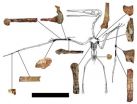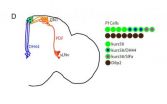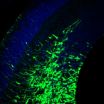(Press-News.org) WASHINGTON—An international research team, including a George Washington University (GW) professor, has discovered and named the earliest and most primitive pterodactyloid—a group of flying reptiles that would go on to become the largest known flying creatures to have ever existed—and established they flew above the earth some 163 million years ago, longer than previously known.
Working from a fossil discovered in northwest China, the project—led by University of South Florida (USF) paleontologist Brian Andres, James Clark of the GW Columbian College of Arts and Sciences and Xu Xing of the Chinese Academy of Sciences—named the new pterosaur species Kryptodrakon progenitor.
Through scientific analysis the team established it as the first pterosaur to bear the characteristics of the Pterodactyloidea, which would become the dominant winged creatures of the prehistoric world. Their research will be published online Thursday in the journal Current Biology.
"This finding represents the earliest and most primitive pterodactyloid pterosaur, a flying reptile in a highly specialized group that includes the largest flying organisms," says Chris Liu, program director in the National Science Foundation's Division of Earth Sciences. "The research has extended the fossil record of pterodactyloids by at least five million years to the Middle-Upper Jurassic boundary about 163 million years ago."
Kryptodrakon progenitor lived around the time of the Middle-Upper Jurassic boundary. Through studying the fossil fragments, researchers also determined that the pterodactyloids originated, lived, and evolved in terrestrial environments—rather than marine environments where other specimens have been found.
The fossil is of a small pterodactyloid with a wingspan estimate of about 4.5 feet. Pterodactyloids—who went on to evolve into giant creatures, some as big as small planes—went extinct with the dinosaurs, about 66 million years ago. Pterosaurs are considered close relatives to the dinosaurs, but are not dinosaurs themselves.
The discovery provides new information on the evolution of pterodactyloids, Dr. Andres said. This area was likely a flood plain at the time the pterosaur lived, Dr. Andres said. As the pterosaurs evolved, their wings changed from being narrow, which are more useful for marine environments, to being more broad near the origin of the pterodactyloids – helpful in navigating land environments.
"He (Kryptodrakon progenitor) fills in a very important gap in the history of pterosaurs," Dr. Andres said. "With him, they could walk and fly in whole new ways."
The fossil that became the centerpiece of the research was discovered in 2001 by Chris Sloan, formerly of National Geographic and now president of Science Visualization. It was found in a mudstone of the Shishugou Formation of northwest China on an expedition led by Drs. Xu and Clark when Dr. Andres was a graduate student with Dr. Clark at GW. The desolate and harsh environment has become known to scientists worldwide as having "dinosaur death pits" for the quicksand in the area that trapped an extraordinary range of prehistoric creatures, stacking them on top of each other, including one of the oldest tyrannosaurs, Guanlong. Kryptodrakon progenitor was found 35 meters below an ash bed that has been dated back to more than 161 million years.
The specimen is housed at the Institute of Vertebrate Paleontology and Paleoanthropology, Beijing, China. The name Kryptodrakon progenitor comes from Krypto (hidden) and drakon (serpent), referring to "Crouching Tiger, Hidden Dragon" filmed near where the species was discovered, and progenitor (ancestral or first-born), referring to its status as the earliest pterodactyloid, Dr. Andres said.
"Kryptodrakon is the second pterosaur species we've discovered in the Shishugou Formation and deepens our understanding of this unusually diverse Jurassic ecosystem," said Dr. Clark, GW's Ronald B. Weintraub Professor of Biology. "It is rare for small, delicate fossils to be preserved in Jurassic terrestrial deposits, and the Shishugou fauna is giving us a glimpse of what was living alongside the behemoths like Mamenchisaurus."
The scientists write that the pterosaurs were a diverse group of Mesozoic flying reptiles that underwent a body plan reorganization, adaptive radiation, and replacement of earlier forms midway through their long history, resulting in the origin of the Pterodactyloidea, a highly-specialized group of pterosaurs of which Kryptodrakon is the earliest and most primitive species.
This new take on the ecological history of pterosaurs is supported by a significant correlation found between wing shape and environment in pterosaurs and modern flying vertebrates, like bats and birds, the researchers said. Pterosaurs, however, are not the ancestors of birds—those are the dinosaurs—and scientists still believe that pterosaurs did not evolve into birds or other modern animals humans would know.
INFORMATION:
The fieldwork was supported by the National Natural Science Foundation of China, the National Science Foundation Division of Earth Sciences of the USA, the Chinese Academy of Sciences, the National Geographic Society, the Jurassic Foundation, the Hilmar Sallee bequest, and the George Washington University. Study of the specimen was supported by the Chinese Academy of Sciences, the National Science Foundation Division of Earth Sciences and the National Natural Science Foundation of China.
The George Washington University
In the heart of the nation's capital with additional programs in Virginia, the George Washington University was created by an Act of Congress in 1821. Today, GW is the largest institution of higher education in the District of Columbia. The university offers comprehensive programs of undergraduate and graduate liberal arts study, as well as degree programs in medicine, public health, law, engineering, education, business and international affairs. Each year, GW enrolls a diverse population of undergraduate, graduate and professional students from all 50 states, the District of Columbia and more than 130 countries.
The University of South Florida
The University of South Florida is a high-impact, global research university dedicated to student success. USF is a Top 50 research university among both public and private institutions nationwide in total research expenditures, according to the National Science Foundation. Serving nearly 48,000 students, the USF System has an annual budget of $1.5 billion and an annual economic impact of $4.4 billion. USF is a member of the American Athletic Conference.
The National Science Foundation
The National Science Foundation (NSF) is an independent federal agency that supports fundamental research and education across all fields of science and engineering. In fiscal year (FY) 2014, its budget is $7.2 billion. NSF funds reach all 50 states through grants to nearly 2,000 colleges, universities and other institutions. Each year, NSF receives about 50,000 competitive requests for funding, and makes about 11,500 new funding awards. NSF also awards about $593 million in professional and service contracts yearly. http://www.nsf.gov
Oldest pterodactyloid species discovered, named by international team of researchers
Study rewrites chapter in understanding of prehistoric world, evolution of great flying beasts
2014-04-24
ELSE PRESS RELEASES FROM THIS DATE:
Fruit fly study identifies brain circuit that drives daily cycles of rest, activity
2014-04-24
PHILADELPHIA - Amita Sehgal, PhD, a professor of Neuroscience at the Perelman School of Medicine, University of Pennsylvania, describes in Cell a circuit in the brain of fruit flies that controls their daily, rhythmic behavior of rest and activity. The new study also found that the fly version of the human brain protein known as corticotrophin releasing factor (CRF) is a major coordinating molecule in this circuit. Fly CRF, called DH44, is required for rest/activity cycles and is produced in cells that receive input from the clock cells in the fly brain. In mammals, CRF ...
Scientists find way to target cells resistant to chemo
2014-04-24
Scientists from The University of Manchester have identified a way to sensitise cancer cells to chemotherapy - making them more open to treatment.
The study published today in Cell Reports, could pave the way for the development of drugs to target cells that have become resistant to treatment.
The research team made the discovery whilst exploring the possible mechanisms behind resistance to chemotherapy drugs like Paclitaxel, often used to treat breast and colon cancer.
Dr Andrew Gilmore, who led the research team at The University of Manchester, is part of both the ...
New type of protein action found to regulate development
2014-04-24
Johns Hopkins researchers report they have figured out how the aptly named protein Botch blocks the signaling protein called Notch, which helps regulate development. In a report on the discovery, to appear online April 24 in the journal Cell Reports, the scientists say they expect the work to lead to a better understanding of how a single protein, Notch, directs actions needed for the healthy development of organs as diverse as brains and kidneys.
The Johns Hopkins team says their experiments show that Botch uses a never-before-seen mechanism, replacing one chemical group ...
Researchers discover new genetic brain disorder in humans
2014-04-24
A newly identified genetic disorder associated with degeneration of the central and peripheral nervous systems in humans, along with the genetic cause, is reported in the April 24, 2014 issue of Cell.
The findings were generated by two independent but collaborative scientific teams, one based primarily at Baylor College of Medicine and the Austrian Academy of Sciences, the other at the University of California, San Diego School of Medicine, the Academic Medical Center (AMC) in the Netherlands and the Yale University School of Medicine.
By performing DNA sequencing ...
Scientists reprogram blood cells into blood stem cells in mice
2014-04-24
BOSTON (April 24, 2014)—Researchers at Boston Children's Hospital have reprogrammed mature blood cells from mice into blood-forming hematopoietic stem cells (HSCs), using a cocktail of eight genetic switches called transcription factors. The reprogrammed cells, which the researchers have dubbed induced HSCs (iHSCs), have the functional hallmarks of HSCs, are able to self-renew like HSCs, and can give rise to all of the cellular components of the blood like HSCs.
The findings mark a significant step toward one of the most sought-after goals of regenerative medicine: the ...
To mark territory or not to mark territory: Breaking the pheromone code
2014-04-24
LA JOLLA, CA— April 24, 2014 —A team led by scientists at The Scripps Research Institute (TSRI) has deciphered the surprisingly versatile code by which chemical cues help trigger some of the most basic behaviors in mice.
The findings shed light on the evolution of mammalian behaviors—which include human behaviors—and their underlying brain mechanisms.
"How does an individual respond differently to the environment based on experience? How does it distinguish itself from others? These are some of the fundamental questions that a study like this one helps us address," ...
Genetic legacy from the Ottoman Empire: Single mutation causes rare brain disorder
2014-04-24
An international team of researchers have identified a previously unknown neurodegenerative disorder and discovered it is caused by a single mutation in one individual born during the Ottoman Empire in Turkey about 16 generations ago.
The genetic cause of the rare disorder was discovered during a massive analysis of the individual genomes of thousands of Turkish children suffering from neurological disorders.
"The more we learn about basic mechanisms behind rare forms of neuro-degeneration, the more novel insights we can gain into more common diseases such as Alzheimer's ...
Oops! Researchers find neural signature for mistake correction
2014-04-24
Culminating an 8 year search, scientists at the RIKEN-MIT Center for Neural Circuit Genetics captured an elusive brain signal underlying memory transfer and, in doing so, pinpointed the first neural circuit for "oops" ? the precise moment when one becomes consciously aware of a self-made mistake and takes corrective action.
The findings, published in Cell, verified a 20 year old hypothesis on how brain areas communicate. In recent years, researchers have been pursuing a class of ephemeral brain signals called gamma oscillations, millisecond scale bursts of synchronized ...
Large-scale identification and analysis of suppressive drug interactions
2014-04-24
TORONTO – Baker's yeast is giving scientists a better understanding of drug interactions, which are a major cause of hospitalization and illness world-wide.
When two or more medications are taken at the same time, one can suppress or enhance the effectiveness of the other. Similarly, one drug may magnify the toxicity of another. These types of interactions are a major cause of illness and hospitalization. However, there are severe practical limits on the practical scope of drug studies in humans. Limits come in part from ethics and in part from the staggering expense. ...
Skin layer grown from human stem cells could replace animals in drug and cosmetics testing
2014-04-24
An international team led by King's College London and the San Francisco Veteran Affairs Medical Center (SFVAMC) has developed the first lab-grown epidermis – the outermost skin layer - with a functional permeability barrier akin to real skin. The new epidermis, grown from human pluripotent stem cells, offers a cost-effective alternative lab model for testing drugs and cosmetics, and could also help to develop new therapies for rare and common skin disorders.
The epidermis, the outermost layer of human skin, forms a protective interface between the body and its external ...
LAST 30 PRESS RELEASES:
Black women hospitalised in USA with blood infection resistant to last-resort antibiotic at increased risk of death
NEC Society Statement on the Watson vs. Mead Johnson Verdict
Lemur’s lament: When one vulnerable species stalks another
Surf clams off the coast of Virginia reappear – and rebound
Studying optimization for neuromorphic imaging and digital twins
ORNL researchers win Best Paper award for nickel-based alloy tailoring
New beta-decay measurements in mirror nuclei pin down the weak nuclear force
Study uncovers neural mechanisms underlying foraging behavior in freely moving animals
Gene therapy is halting cancer. Can it work against brain tumors?
New copper-catalyzed C-H activation strategy from Scripps Research
New compound from blessed thistle promotes functional nerve regeneration
Auburn’s McCrary Institute, ORNL to partner on first regional cybersecurity center to protect the nation’s electricity grid
New UNC-Chapel Hill study examines the increased adoption of they/them pronouns
Groundbreaking study reveals potential diagnostic marker for multiple sclerosis years before symptom onset
Annals of Internal Medicine presents breaking scientific news at ACP’s Internal Medicine Meeting 2024
Scientists discover new way to extract cosmological information from galaxy surveys
Shoe technology reduces risk of diabetic foot ulcers
URI-led team finds direct evidence of ‘itinerant breeding’ in East Coast shorebird species
Wayne State researcher aims to improve coding peer review practices
Researchers develop a new way to safely boost immune cells to fight cancer
Compact quantum light processing
Toxic chemicals from microplastics can be absorbed through skin
New research defines specific genomic changes associated with the transmissibility of the monkeypox virus
Registration of biological pest control products exceeds that of agrochemicals in Brazil
How reflecting on gratitude received from family can make you a better leader
Wearable technology assesses surgeons’ posture during surgery
AATS and CRF® partner on New York Valves: The structural heart summit
Postpartum breast cancer and survival in women with germline BRCA pathogenic variants
Self-administered acupressure for probable knee osteoarthritis in middle-aged and older adults
2024 Communicator Award goes to “Cyber and the City” research team based in Tübingen
[Press-News.org] Oldest pterodactyloid species discovered, named by international team of researchersStudy rewrites chapter in understanding of prehistoric world, evolution of great flying beasts






